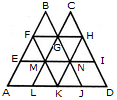Discussion
Home ‣ Non Verbal Reasoning ‣ Analytical Reasoning See What Others Are Saying!
- Question
Find the number of triangles in the given figure.

Options- A. 16
- B. 18
- C. 14
- D. 15
- Correct Answer
- 18
ExplanationThe figure may be labelled as shown.
The simplest triangles are BFG, CGH, EFM, FMG, GMN, GHN, HNI, LMK, MNK and KNJ i.e. 10 in number.
The triangles composed of three components each are FAK and HKD i.e. 2 in number.
The triangles composed of four components each are BEN, CMI, GLJ and FHK i.e. 4 in number.
The triangles composed of eight components each are BAJ and OLD i.e. 2 in number.
Thus, there are 10 + 2 + 4 + 2 = 18 triangles in the given figure.
More questions
- 1. Choose the correct figure to complete the matrix.
Options- A. (a)
- B. (b)
- C. (c)
- D. (d) Discuss
Correct Answer: (b)
Explanation:
NA
- 2. NA
Options- A. 1
- B. 2
- C. 3
- D. 4 Discuss
Correct Answer: 1
Explanation:
NA
- 3. NA
Options- A. 1
- B. 2
- C. 3
- D. 4 Discuss
Correct Answer: 1
Explanation:
NA
- 4. NA
Options- A. 1
- B. 2
- C. 3
- D. 4 Discuss
Correct Answer: 2
Explanation:
NA
- 5. REASONING
Options- A. .
- B. .
- C. .
- D. . Discuss
Correct Answer: .
Explanation:
Answer A
- 6. NA
Options- A. 1
- B. 2
- C. 3
- D. 4 Discuss
Correct Answer: 3
Explanation:
NA
- 7. NA
Options- A. 1
- B. 2
- C. 3
- D. 4 Discuss
Correct Answer: 3
Explanation:
NA
- 8. P1PA2PU
Options- A. .
- B. .
- C. .
- D. . Discuss
Correct Answer: .
Explanation:
Answer B
- 9. MISSISSIPPI
Options- A. .
- B. .
- C. .
- D. . Discuss
Correct Answer: .
Explanation:
Answer A
- 10. NA
Options- A. 1
- B. 2
- C. 3
- D. 4 Discuss
Correct Answer: 4
Explanation:
NA
Comments
There are no comments.
- 1.
Programming
Copyright ©CuriousTab. All rights reserved.
